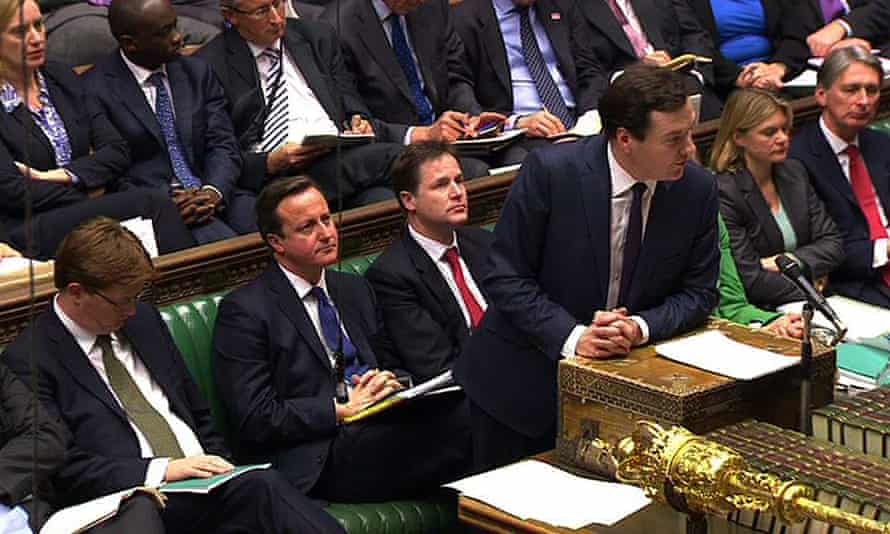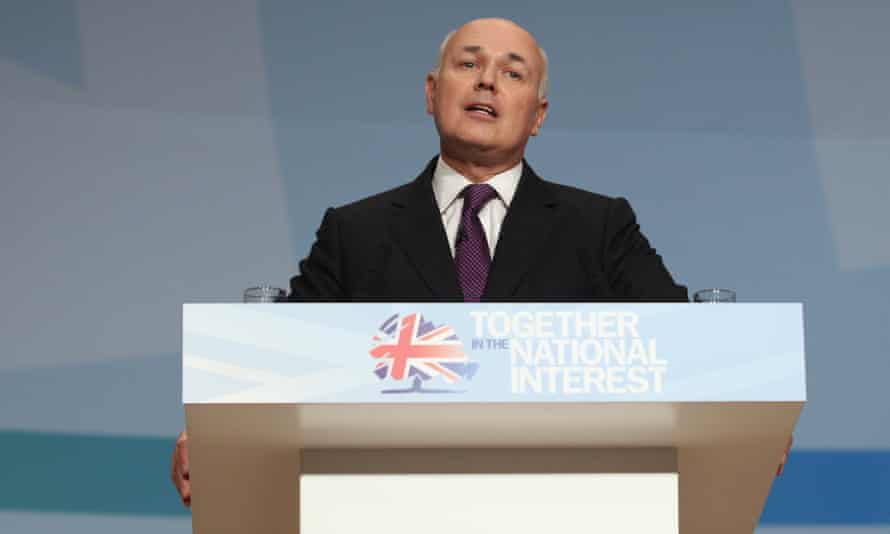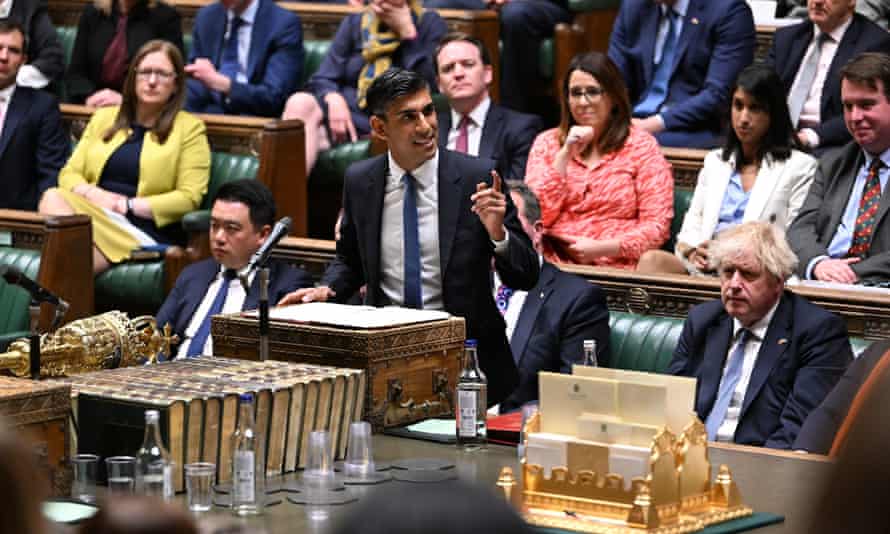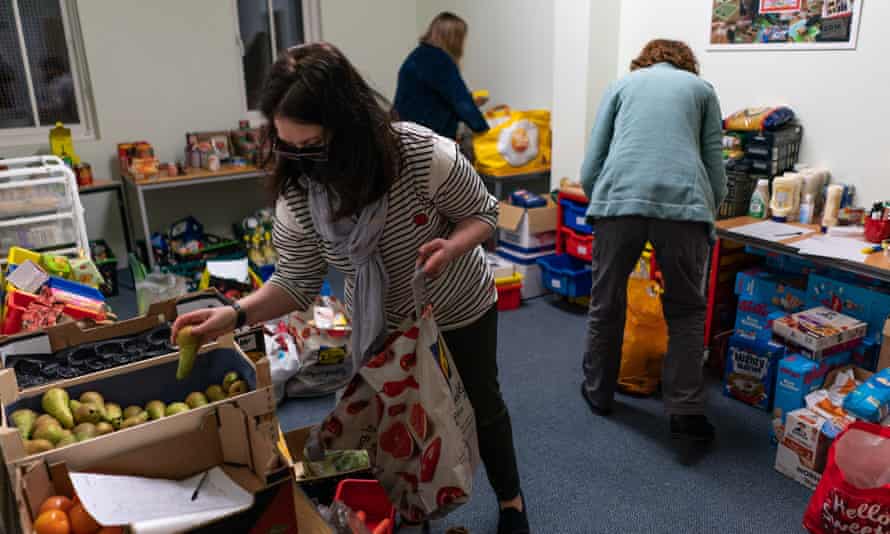[ad_1]
Listening to the prime minister and his colleagues, you would be forgiven for considering that the mounting price of dwelling disaster got here out of the blue. As they see it, alongside got here the conflict in Ukraine and what Boris Johnson has known as “the aftershocks of Covid”, triggering rocketing inflation. Immediately, the hole between individuals’s incomes and rising costs turned lives the other way up.
In reality, for thousands and thousands of individuals in Britain, 2022’s rising sense of catastrophe is one other chapter in a narrative that goes again at the very least 10 years – to guidelines and laws that turned the welfare state into a multitude of trapdoors and tripwires, to the hacking again of advantages, to the dire remedy of disabled individuals and to a brand new world of labor the place power insecurity and flatlining pay are an on a regular basis actuality.
How did we get right here? Through the New Labour years, between 1997 and 2010, there was an emphasis on clamping down on “profit cheats” and making Britain’s social safety system extra stringent. However the Blair and Brown governments additionally vowed to chop baby poverty by at the very least 1 million by utilizing such measures as tax credit. Regardless of an upward blip across the time of the crash of 2007-08, they succeeded.
The federal government of David Cameron, Nick Clegg and George Osborne was slightly totally different. The tone and the language main politicians used to speak about advantages, poverty and work turned much more poisonous, opening the best way for drastic adjustments to what was now being known as “welfare”.
Now, the prejudices and resentments of individuals exterior the advantages system appeared to matter greater than the individuals who wanted assist to attempt to keep afloat. “Equity isn’t nearly who will get assist from the state,” mentioned Cameron in October 2010, 5 months after changing into prime minister. “The opposite a part of the equation is who offers that assist, via their taxes. Taking extra money from the person who goes out to work lengthy hours every single day so the household subsequent door can go on dwelling a life on advantages with out working – is that honest? … Should you can work, however refuse to work, we won’t allow you to stay off the arduous work of others.”

Welfare coverage was pushed by austerity, which was so drastic that an estimated £37bn was lower from advantages spending between 2010 and 2021. Proper at first, the brand new coalition authorities introduced £11bn of “welfare reform financial savings”. Advantages have been linked to the buyer costs index, a measure of inflation that tended to be decrease than the earlier measure. Housing profit was lower. In the meantime, the rise of insecure work continued apace – and plans have been hatched for much more drastic adjustments.
A few of us have adopted what has unfolded since, monitoring the related information and figures, in addition to individuals’s experiences – of starvation, hardship and worry. Lastly, on the finish of Could, the federal government bowed to months of strain and introduced a sizeable package deal of assist, a lot aimed on the individuals struggling essentially the most. However the measures are momentary and massive questions stay.
In the meantime, on the final rely, in January, the quantity of people that had their advantages stopped or lower – often for lacking a gathering on the jobcentre – was near 40,000. The individuals in energy stay largely reluctant to intervene in essentially the most insecure, exploitative corners of the economic system, so the disaster grinds on. It isn’t one thing that arrived in a flash, however one other episode in a really lengthy saga.
Common credit score

An array of adjustments to the UK’s advantages system was carried out by the Welfare Reform Act 2012. The largest change was the introduction of common credit score, a catch-all month-to-month cost designed to interchange six working-age advantages. “It’s time to convey welfare into the twenty first century,” mentioned its champion, the work and pensions secretary – and former Tory chief – Iain Duncan Smith. “We would like a system which isn’t seen as a doorway to hopelessness and despair, however as a substitute as a doorway to actual aspiration and achievement.”
Its introduction was a lot delayed and is nonetheless not totally full. However there was anxiousness from the off concerning the swap from a mix of advantages paid month-to-month, weekly and fortnightly to a once-a-month cost that in lots of circumstances made budgeting harder for recipients.
There was additionally dismay about baby profit being included in a single cost paid to households, slightly than being paid to moms, which successfully transferred thousands and thousands of funds to males. “That comes up loads in home violence circumstances, the place these points change into immediately very stark,” says Alison Garnham, the chief govt of the Little one Poverty Motion Group (CPAG). “However we’re anxious typically about what’s occurred to baby profit. It’s misplaced almost 1 / 4 of its worth in 10 years. What was our exemplary common profit is now in bother and it desperately must be rescued.”
There are additionally main issues with the in-built delay – of 5 weeks or longer – between making use of for common credit score and receiving any cash, main individuals into unattainable ranges of debt. Small surprise that the meals financial institution charity the Trussell Belief mentioned in 2017 that demand for its parcels had gone up by 30% in areas the place the introduction of common credit score was at its most superior.
Incapacity funds

Maybe essentially the most obtrusive side of 10 years of cuts and so-called welfare reform considerations the terrible remedy of disabled individuals. Conveniently sufficient for the federal government, it’s a story a couple of difficult mess of adjustments. It’s now a rule of thumb that when the advantages system is “reformed”, disabled individuals bear the brunt – one thing seen in every little thing from the toughening of so-called work functionality assessments in 2011 to the substitute of incapacity dwelling allowance with the private independence cost in 2013. What is evident is that 30% of the 13 million individuals with disabilities within the UK – 3.8 million adults and 300,000 youngsters – stay in poverty.
There is no such thing as a finish of stark information underlying these figures. As a part of the introduction of common credit score, the federal government removed the extreme incapacity premium, depriving disabled adults who stay on their very own – or with solely a younger carer – of about £58 per week. Since 2017, employment and assist allowance – a profit paid to individuals who have a incapacity or well being situation that impacts how a lot they’ll work – has been decreased by about £30 per week for a lot of new claimants.
So-called sanctions, whereby individuals’s advantages are stopped, usually for minor alleged breaches of the principles, have disproportionately affected disabled individuals. In 2018, one research discovered that unemployed disabled individuals have been as much as 53% extra possible to have their funds docked than non-disabled individuals.
Worse nonetheless, for the reason that cash that used to go from Westminster and Whitehall to councils has been lower repeatedly, many native authorities have launched or elevated costs for disabled individuals’s social care. “All of them began bringing in comparable new insurance policies that elevated the quantity they might cost individuals,” says Ellen Clifford, a disability-rights activist and the creator of The Warfare on Disabled Individuals. “Which means a variety of disabled individuals are having to pay way more for his or her social care, which leaves them little or no to stay on. The advantages they obtain go straight out once more.”
The profit cap
This was the epitome of the coalition’s strategy to welfare: an absolute restrict on profit funds, pegged to common particular person earnings from work. It was a blatantly political transfer, geared toward voters who believed the tales that there have been individuals dwelling lives of luxurious on the state’s expense. Osborne, the chancellor on the time, summarised it bluntly as “cash to households who want it – however no more cash than households who exit to work. That’s what the British individuals imply by honest – and we would be the first authorities in historical past to convey it about.”
The cap was launched in 2013 and set at £500 per week (£26,000 a yr). For single individuals, it was £350 per week. Three years later, the cap got here all the way down to £23,000 a yr for households in Larger London and £15,410 for single individuals within the capital. Elsewhere within the nation, the figures have been £20,000 and £13,400. Duncan Smith mentioned the adjustments would “re-emphasise the message that it’s not honest for somebody on advantages to be receiving greater than somebody in work”.
As a result of having young children usually makes working unattainable (mainly due to childcare prices), mother and father endure the worst of the cap’s results. Certainly, 85% of capped households have children, whereas 65% of all capped households are single mother and father – individuals who have a tendency to wish advantages within the absence of a working companion. In the event that they stay in a high-cost housing space reminiscent of London, being capped is usually inevitable – annual hire within the capital can simply prime £20,000, which leaves a pittance to cowl every little thing else.
Aurora is likely one of the many individuals whose lives have been ruined by the cap. A widow and single mom of two from outer London, she desires to work, however has discovered that childcare points make this unattainable (“I had to surrender my final job a month in the past, as a result of my youngest continues to be in major faculty and I wouldn’t have been in a position to choose him up on time”). She and her children stay in a privately rented residence, for which she pays £1,800 a month. The cap means they’re left with about £1,400 a yr to stay on. The additional cash Rishi Sunak just lately granted to the poorest households – a £650 one-off cost, in addition to a £400 low cost on vitality payments given to all households and a £150 council tax rebate – won’t change her primary predicament.
“I’m in an enormous quantity of debt,” she says. “An enormous quantity. I’ve been fighting that and on the lookout for work. I’m principally caught on this cycle. It’s unending. And now the prices of every little thing else are rising and I don’t know what’s going to occur. We’re going to be made homeless, which can price the federal government extra.”

The bed room tax
This was maybe essentially the most infamous aspect of the Welfare Reform Act 2012. The coalition known as it the “underoccupancy cost” or “spare room subsidy”, however nearly right away the identify that caught was the bed room tax. Individuals dwelling in council housing or houses they rented from housing associations would have their housing profit decreased by 14% if they’d a spare bed room, or 25% if they’d two or extra. Supposedly, it will encourage a extra environment friendly use of housing area.
A yr afterwards, analysis by the BBC advised that solely about 6% of individuals affected had moved residence. For the remainder, the change merely meant much less cash and unattainable budgeting selections. One household of six I met in Hartlepool – who wanted their “spare” room as a sensory area for an autistic baby – noticed their weekly housing profit fall by £28 per week, which instantly pushed them additional into meals poverty.
Between March and November 2020, because the quantity of people that wanted common credit score shot up due to the pandemic, the variety of individuals affected by the bed room tax rose by 40%, to 238,748. It’s barely talked about any extra, nevertheless it stays an enormous think about many individuals’s incapability to satisfy their most simple dwelling prices.
Precarious work

Ten years in the past, jobs wherein workers had no thought what number of hours they’d be working – and thus how a lot they’d be incomes – from one week to the subsequent felt like a relative novelty. However, in 2014, a change in how official figures have been calculated revealed the true extent of the issue. About half 1,000,000 individuals have been on zero-hours contracts. By 2020, that determine had doubled, which is likely one of the explanation why about 15% of the individuals who often use meals banks are considered in work.
Conservative politicians have constantly refused to do something significant concerning the zero-hours difficulty, which is strongly linked to the best way the advantages system works, summed up by the time period “conditionality”. Put merely, for round a decade, the state has pushed individuals into taking any work obtainable below ache of getting their advantages stopped, so individuals can do treasured little to contest insecure circumstances and poor wages. “It was all supposed to pressure individuals into low-paid work,” says the CPAG’s Garnham. “What it hasn’t completed is raise them out of poverty. We’ve completed welfare to work. What we’ve not completed is poverty to out-of-poverty.”
The advantages freeze
In 2014, Osborne introduced his plan for a two-year advantages freeze, if the Conservatives have been returned to energy, to save lots of one other £3bn. In the summertime of 2015, he confirmed the period of the freeze could be doubled. It lastly ended in April 2020, simply after the beginning of the pandemic. It had affected just below 30 million individuals, lower the real-terms worth of advantages by 6% since 2015, left the typical poor couple with youngsters £580 a yr worse off and pushed 400,000 individuals into poverty.
The 2-child restrict

This was designed, in keeping with Duncan Smith, to “educate mother and father that youngsters price cash”. It was central to the welfare reform invoice that Labour MPs have been instructed to abstain on – a infamous episode that was one of many key components in propelling Jeremy Corbyn to the occasion management. The 2-child restrict – a crude restriction on baby tax credit and common credit score funds to households, with the caveat that twins and triplets weren’t penalised – was launched in 2017.
In April, analysis funded by the Nuffield Basis discovered that the numbers of third and subsequent youngsters born to poorer households had barely fallen. However the two-child restrict had change into the most important single driver of kid poverty, depriving three-child households of £250 a month, or £3,000 a yr.
Sayeeda is a single mom who lives in South Yorkshire. I used to be put in contact together with her by the Profit Modifications and Bigger Households undertaking, which tracks the impression of the two-child restrict and the profit cap. Sayeeda receives about £1,600 a month in advantages, together with simply over £500 for 2 of her three children (aged 13, 11 and two). As soon as her payments and hire are paid, the household has about £20 a day to stay on.
“Each month is a battle,” she says. “I’m at all times in some type of debt, simply to tide me over.” She is in debt to her fuel and electrical energy suppliers. After we converse, she has simply been hit with a £300 superb for driving a borrowed automotive whereas uninsured: “We in all probability wouldn’t eat for the subsequent month if I paid that multi functional go.”
If she received one other £250 for her third baby, she says, issues may be manageable. “It could take a variety of stress off my head. I wouldn’t continuously be worrying about feeding my children. I may simply purchase just a few extra issues with out eager about the fee on a regular basis. I’ve to be sure that each penny is accounted for.”
Flatlined wages
After the crash of 2008, the UK turned a byword for stagnant pay. Why this occurred is unclear, however low productiveness is a part of the reason, together with workers’ weak bargaining energy and the expansion of insecure, low-paid work. However the information are stark: between 1992 and 2008, actual wages went up by 36%; for 2008 to 2024, the Workplace for Finances Accountability expects an increase of simply 2.4%.
So far as the 5.7 million individuals within the public sector are involved, the truth that wages have did not hold tempo with costs has been a deliberate coverage. In 2009, Labour capped public-sector pay rises at 1% for 2 years from 2011; a yr later, Osborne froze public-sector salaries for 2 years, then capped any rises at 1% or a mean of 1%, a coverage that got here to an finish solely in 2017. Sunak launched one other year-long freeze in November 2020, for public sector staff exterior the NHS. All this fed right into a rising difficulty for lecturers, police, firefighters, jobcentre employees and the remainder. Current figures present that the median public sector pay award was a mere 1.4% within the yr to March 2022 (within the personal sector, the determine was 2.2%).
The top of the common credit score uplift
On 20 March 2020, Rishi Sunak introduced that the federal government was elevating common credit score’s “normal allowance” by £1,000 a yr, which meant a £20-a-week enhance. “When individuals began to obtain it, they mentioned how a lot of a distinction it made,” says CPAG’s Garnham. “On that stage of earnings, small quantities of cash make an enormous distinction.” This enhance was not granted to the 1.4 million individuals estimated to be on the “legacy” advantages that common credit score is changing, about 75% of whom are disabled.
In October, regardless of an enormous marketing campaign, the “uplift” was delivered to an finish, a transfer that the thinktank the Legatum Institute mentioned would push one other 840,000 individuals into poverty, 290,000 of whom have been youngsters. Lils, a mum of two whom I met just lately in Plymouth, instructed me that it had a dire impact. “It was like giving somebody one thing to eat after which snatching half of it away,” she mentioned. “To me, that cash was an additional £20 on the electrical.” The federal government’s new assist for poor households could also be an enormous transfer, nevertheless it merely places individuals like Lils again to the place they have been earlier than the “uplift” was ended.
The advantages enhance of three%
In April, year-on-year inflation hit 9%. That month, advantages have been “uprated” by solely 3.1%, a determine primarily based on the inflation charge within the yr to September 2021. Subsequent yr, advantages will rise by a a lot bigger determine, however that’s chilly consolation for thousands and thousands of individuals as they wrestle to make it via one other 12 months. Observe that nothing the federal government has introduced will get close to the uplift that households who want advantages would expertise if their funds have been elevated according to value rises.
“Principally, what we’ve gone via is an enormous squeeze on low-income households, adopted by a price of dwelling hike,” says Garnham. “You possibly can’t perceive the impression of 1 with out the opposite.” These two tales have had a huge effect on the lives of thousands and thousands of individuals, however what of the politicians whose concepts and insurance policies outlined a lot of what occurred after 2010?
Cameron was final within the headlines for hustling for presidency contracts on behalf of a now defunct finance firm reckoned to have paid him about £7m. Clegg has his very profitable gig at Meta, the corporate that was known as Fb; his annual wage has been put at about £2.7m, whereas his current promotion introduced him a inventory package deal reckoned to be price £9.4m. Osborne, in the meantime, has a full-time job at a “boutique funding financial institution” in Mayfair known as Robey Warshaw, the place, in 2021, the highest-earning “companion” was paid the perfect a part of £20m.
[ad_2]
Source_link


